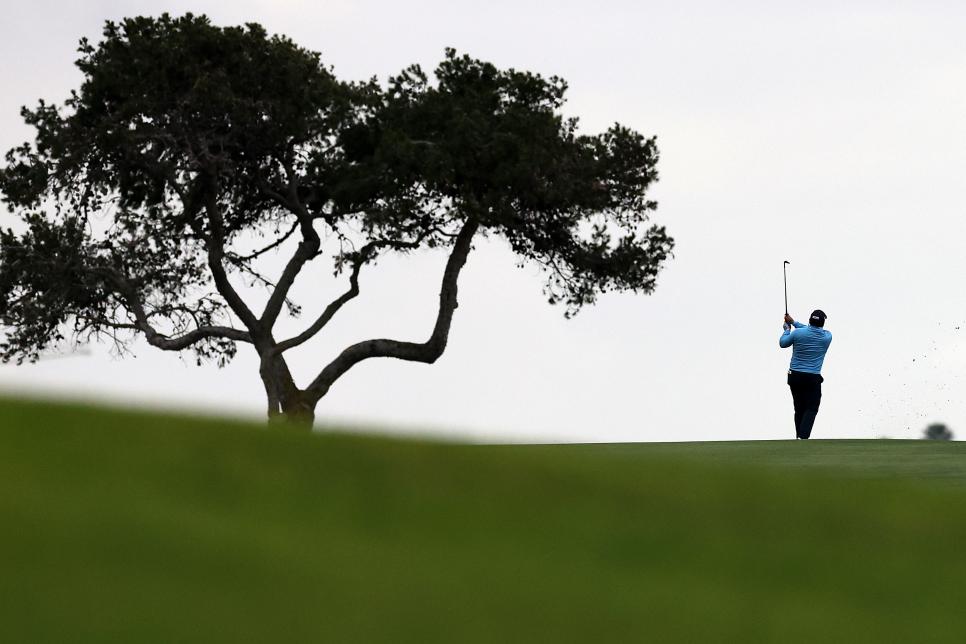Rollback reaction
At Torrey Pines, golfers have more questions than answers about how the ball rollback will affect them

An aerial view of the Torrey Pines South Course.
Ben Jared
SAN DIEGO — Even in early December, the sun shines most of the time, and this week the temperature has been in the high 60s at the Torrey Pines municipal golf courses. No one living east of Arizona is going to feel sorry for members of the Torrey Pines Men’s Club, but the group’s golfers will tell you that this is their least favorite time of year. It’s rough growing season on the South and North courses as the site prepares to host the PGA Tour’s Farmers Insurance Open in late January.
Searching for balls in the unmowed, five-inch jungle becomes a predictable and maddening part of any round—so much so that the starters offer a reminder on the first tee to spend no more than a minute looking for a ball, lest your noon tee time come to an end with you playing by your phone’s flashlight.
In other words, golf is challenging enough at Torrey Pines, so when the players in the men’s club hear that they might be further taxed by a rule that will make their golf balls fly shorter—well, they’re about as happy as playing behind picture-taking tourists from Iowa.
“I don’t want to be too dramatic about this, but I can ill afford to lose any yardage,” Larry Prosi, the 75-year-old president of the TPMC, said this week in advance of the USGA and R&A formally announcing their plans for a universal rollback of the golf ball. “If you’re taking away the enjoyment of the game, why?”
Added Roy Burchill, 70, a former TPMC president, “We all focus on length and hitting the ball as far as we can. We aren’t the problem. It’s the guys on tour hitting it 340 and 350 yards, playing golf courses as they were not designed to be played.
“We have to follow the rules,” he added, “but no one is saying the LPGA is hitting the ball too far. I think we’re focusing on less than 1 percent of the golfers in the world, and to change the rules based on them, I don’t support that.”
In announcing the change to the Overall Distance Standard test that will limit ball distance, set to be instituted for the elite golfers in 2028 and amateurs in 2030, the USGA and R&A said that the greatest loss of distance will come at golf’s top professional levels, with a reduction of 13-15 yards for PGA Tour and DP World Tour players using drivers. Average professional tour and elite male players are expected to see a reduction of 9-11 yards, with 5-7 yard reduction for an average LPGA and LET player. They contend the new limits will have the least impact on higher-handicapped and slower-swinging golfers. “The change in testing speed is expected to have a minimal distance impact, five yards or less, for most recreational golfers,” the announcement said.
If the distance loss truly is minimal, the Torrey Pines golfers, who are members of one of the largest clubs in the country at 1,169 players, say they wouldn’t have a problem with the rollback. But without seeing the true effect, they are apprehensive, because they agree that they would rather not lose a single yard in distance when aging is already diminishing their skills.
“Ten years ago, my swing speed was 106 [mph] with my driver,” said TPMC member Dan Moore, 67, who carries a 4.9 index. “Now, I barely get to 95 and 96. I know it’s only going to continue down that road. The argument I’ve been reading is that we’ll just move up to the next tees and make it up by playing a shorter course. Am I happy about that? Not really.”
Countered another longtime member, Bob Hood, “I’m already playing the most forward tees. Are they going to build new tees to adjust to the new ball?”
Moore argues that the governing bodies should have chosen bifurcation and left amateurs alone. “I think we already have bifurcation; we’re just not calling it that,” he said. “Tiger [Woods] and Rory [McIlroy] are playing different balls than we are. All of their equipment is different than ours.”

A golfer hits a shot on the fourth hole of Torrey Pines South.
Sean M. Haffey
The implications for introducing a new ball to the game go far beyond distance. Already, some golfers—64 percent in a Golf Digest internet poll—say they won’t use a shorter-flying ball despite it being a USGA rule. What happens if some players in your group want to abide by the rules, but others just want to hit the ball as far as they can? The Torrey Pines members grudgingly say they would use an approved ball in competition but aren’t sure that they’d put it into play in casual rounds.
“With my skill set, I’ll play any ball that’s round,” joked Hood, 78.
Added Prosi, “I would probably play the regular [non-conforming] ball with buddies. The question is, to post or not to post? My gut reaction is that I’d probably post, at least until I ran out of the balls.”
The problem with going back and forth between balls is that there won’t be any game consistency. “That’s going to screw you up,” said Burchill, who adds that there’s not a round he plays that there’s not some money on the line. Therefore, he would d play the ball his group agrees to use.
In the few days since news of the impending USGA/R&A announcement was out, there already was buzz about the hoarding of the current legal balls. If the manufacturers choose not to produce those when the new testing goes into effect, Hood wondered if there will be a lucrative black market. “I’ve got three 5-gallon cans of balls,” he said. “I was going to donate them, but maybe I’ll get a washer and some paint and start selling balls.”
Burchill said he understands the governing bodies are in a difficult position. Some storied courses are nearing obsolescence due to the game’s current bombers. There is a strong argument for stemming that decay. But he also works as a walking scorer each year at the Farmers and hears the fans “oooh” and ahhh” at the players’ power. “That why people go to see pro golfers,” Burchill said, “to see how far they hit the ball. Is the game being destroyed by how far they hit it? It seems like the game is at its highest popularity ever.”
Moore worries about how a potential loss of distance could hinder new people coming to the game. “You take away distance, and it’s going to be more and more discouraging,” he said.
With seven years of buildup to when the new balls are required for amateurs, there is plenty of time for discovery and debate. Maybe golfers will be laughing about the unnecessary fuss made in the early 2020s about losing distance. Or they could rue this very day of the announcement.
With the ball change seven years in the distance, Hood looks ahead to the year that he'll be 85, and the distance debate becomes less of a concern. “At that age,” he said, “I want to be able to put the tee into the ground and then be able to stand back up.”




